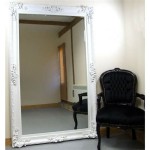Floor to Ceiling Bedroom Mirrors: A Comprehensive Guide
Floor to ceiling mirrors have become a popular design element in modern bedrooms, offering a range of aesthetic and functional benefits. Understanding their advantages, the various types available, and how to incorporate them effectively can significantly enhance a bedroom's overall design.
Expanding the Perceived Space
One of the most significant advantages of floor to ceiling mirrors is their ability to create the illusion of a larger space. By reflecting the room, these mirrors effectively double the visual area, making smaller bedrooms appear more spacious and open. This is particularly beneficial in urban apartments or homes with limited square footage. The strategic placement of such a mirror can maximize this effect, reflecting natural light and brightening the room further.
The reflection of light also plays a crucial role in enhancing the overall ambiance of the room. A well-placed floor to ceiling mirror can capture and distribute natural light throughout the bedroom, reducing the need for artificial lighting during the day. This not only contributes to a brighter, more inviting space but also promotes energy efficiency.
Variety and Style
Floor to ceiling mirrors are available in a variety of styles and frames to complement diverse interior design aesthetics. Frameless mirrors offer a sleek, minimalist look, seamlessly integrating into the wall and maximizing the reflective surface. For a more traditional approach, framed mirrors are available in various materials, including wood, metal, and resin, adding a decorative touch to the room. These frames can be chosen to match existing furniture and decor, creating a cohesive and harmonious aesthetic.
Beyond traditional rectangular shapes, floor to ceiling mirrors can be customized to fit specific design needs. Curved mirrors introduce a unique, contemporary element, while segmented mirrors can create interesting visual patterns. The flexibility in shape and size allows for creative integration into various bedroom layouts and design schemes.
Practical Applications and Considerations
Beyond their aesthetic contributions, floor to ceiling mirrors serve a practical purpose in the bedroom. They provide a full-length view, essential for checking outfits and ensuring a polished appearance before leaving the house. This functionality eliminates the need for a separate, smaller dressing mirror, saving space and streamlining the room's design.
However, incorporating floor to ceiling mirrors requires careful planning and consideration. Placement is crucial to avoid awkward reflections or unnecessary glare. Positioning the mirror opposite a window can maximize natural light reflection but also introduce glare if not carefully managed. Similarly, the mirror's reflection should complement the existing decor and avoid reflecting cluttered areas, which can amplify the appearance of disorder.
Installation and Maintenance
Proper installation is essential for the safety and longevity of floor to ceiling mirrors. Professional installation is recommended, especially for larger or heavier mirrors, to ensure secure mounting and prevent accidents. Depending on the size and weight, specialized hardware and mounting techniques might be required. Consulting with a professional can ensure the mirror is installed correctly and safely.
Maintaining the pristine appearance of a floor to ceiling mirror requires regular cleaning. Using a suitable glass cleaner and a soft, lint-free cloth can effectively remove fingerprints, dust, and smudges. Regular cleaning not only maintains the mirror's reflectivity but also contributes to the overall cleanliness and aesthetic of the bedroom.
Integrating with Existing Decor
Seamlessly integrating a floor to ceiling mirror into existing decor involves considering the surrounding furniture and color palette. The mirror's frame, if any, should complement the existing furniture styles, whether modern, traditional, or eclectic. Additionally, the mirror's placement should consider the reflection of existing colors and patterns to ensure a harmonious and visually appealing result. Thinking of the mirror as an integral part of the overall design scheme, rather than a standalone element, ensures a cohesive and well-balanced aesthetic.
The use of floor to ceiling mirrors in bedrooms offers a powerful design tool. By carefully considering placement, style, and integration with existing decor, these mirrors can significantly enhance the aesthetic appeal and functionality of the space. Understanding the benefits and practical considerations allows for informed decisions and optimal utilization of this versatile design element.

Floor To Ceiling Mirrors Transitional Bedroom Adore

Floor To Ceiling Mirrors Contemporary Bedroom Adore

Pretty Small Bachelor Bedroom Decorating Ideas Infosofa Remodel Designs

Pin On Reno

Floor To Ceiling Mirror Design Ideas

Floor To Ceiling Mirrors As Functional And Decorative Interior Item Bedroom Design Closet Wardrobe

Floor To Ceiling Mirrors

Floor To Ceiling Mirrored Wardrobes Glide Slide

Ceiling Mirrors For Bedrooms Remodel Bedroom Small Design

Full Length Mirror Floor To Ceiling Fitting Arched Home Bedroom Dressing Solid Wood Frame Rounded Arch Large China Wall Made In Com








